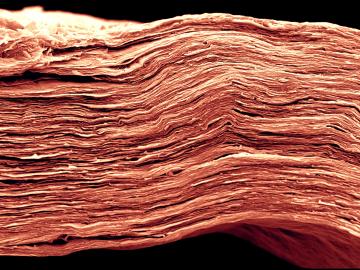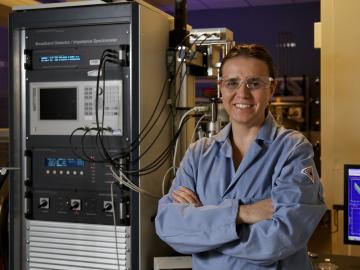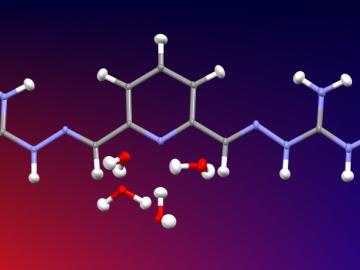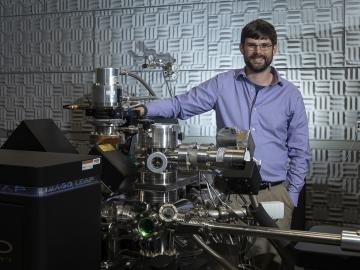
Filter News
Area of Research
- (-) Energy Science (149)
- (-) Materials (128)
- Advanced Manufacturing (10)
- Biological Systems (1)
- Biology and Environment (40)
- Computational Biology (2)
- Computational Engineering (2)
- Computer Science (7)
- Electricity and Smart Grid (3)
- Fuel Cycle Science and Technology (1)
- Functional Materials for Energy (1)
- Fusion and Fission (32)
- Fusion Energy (10)
- Isotope Development and Production (1)
- Isotopes (12)
- Materials Characterization (1)
- Materials for Computing (20)
- Materials Under Extremes (1)
- National Security (30)
- Neutron Science (129)
- Nuclear Science and Technology (41)
- Nuclear Systems Modeling, Simulation and Validation (1)
- Quantum information Science (1)
- Sensors and Controls (1)
- Supercomputing (63)
- Transportation Systems (2)
News Topics
- (-) Biomedical (10)
- (-) Composites (19)
- (-) Grid (40)
- (-) Machine Learning (10)
- (-) Materials Science (90)
- (-) Neutron Science (42)
- (-) Nuclear Energy (22)
- (-) Space Exploration (5)
- (-) Statistics (1)
- (-) Transportation (70)
- 3-D Printing/Advanced Manufacturing (90)
- Advanced Reactors (9)
- Artificial Intelligence (13)
- Big Data (7)
- Bioenergy (30)
- Biology (12)
- Biotechnology (4)
- Buildings (38)
- Chemical Sciences (33)
- Clean Water (10)
- Computer Science (36)
- Coronavirus (14)
- Critical Materials (19)
- Cybersecurity (10)
- Energy Storage (85)
- Environment (64)
- Exascale Computing (3)
- Fossil Energy (2)
- Frontier (3)
- Fusion (7)
- High-Performance Computing (9)
- Hydropower (3)
- Irradiation (1)
- Isotopes (13)
- ITER (1)
- Materials (94)
- Mathematics (3)
- Mercury (3)
- Microelectronics (1)
- Microscopy (29)
- Molten Salt (3)
- Nanotechnology (41)
- National Security (6)
- Partnerships (16)
- Physics (28)
- Polymers (21)
- Quantum Computing (3)
- Quantum Science (12)
- Security (7)
- Simulation (4)
- Summit (6)
Media Contacts

Oak Ridge National Laboratory’s latest Transportation Energy Data Book: Edition 37 reports that the number of vehicles nationwide is growing faster than the population, with sales more than 17 million since 2015, and the average household vehicle travels more than 11,000 miles per year.


OAK RIDGE, Tenn., March 1, 2019—ReactWell, LLC, has licensed a novel waste-to-fuel technology from the Department of Energy’s Oak Ridge National Laboratory to improve energy conversion methods for cleaner, more efficient oil and gas, chemical and

Vera Bocharova at the Department of Energy’s Oak Ridge National Laboratory investigates the structure and dynamics of soft materials.

Researchers used neutron scattering at Oak Ridge National Laboratory’s Spallation Neutron Source to investigate the effectiveness of a novel crystallization method to capture carbon dioxide directly from the air.

Scientists have tested a novel heat-shielding graphite foam, originally created at Oak Ridge National Laboratory, at Germany’s Wendelstein 7-X stellarator with promising results for use in plasma-facing components of fusion reactors.

Oak Ridge National Laboratory scientists have created open source software that scales up analysis of motor designs to run on the fastest computers available, including those accessible to outside users at the Oak Ridge Leadership Computing Facility.

OAK RIDGE, Tenn., Feb. 8, 2019—The Department of Energy’s Oak Ridge National Laboratory has named Sean Hearne director of the Center for Nanophase Materials Sciences. The center is a DOE Office of Science User Facility that brings world-leading resources and capabilities to the nanoscience resear...
![Coexpression_hi-res_image[1].jpg Coexpression_hi-res_image[1].jpg](/sites/default/files/styles/list_page_thumbnail/public/Coexpression_hi-res_image%5B1%5D_0.jpg?itok=ww635BCP)
While studying the genes in poplar trees that control callus formation, scientists at Oak Ridge National Laboratory have uncovered genetic networks at the root of tumor formation in several human cancers.

Jon Poplawsky, a materials scientist at the Department of Energy’s Oak Ridge National Laboratory, develops and links advanced characterization techniques that improve our ability to see and understand atomic-scale features of diverse materials


